Arrakis—Dune—Deck-Builder.
Paul Dennen gets deck-building games. More importantly, he gets that deck-building is an under-leveraged mechanism. Wait, you might be saying, aren’t there one billion deck-building games? Yes. More deck-building games than there are grains of sand in the sea. But not all of them are slick hybrid titles like Clank!, which mixed deck-building with just enough beyond-the-deck considerations to make it worthwhile. While the rest of the hobby lags behind Martin Wallace’s multiple experiments in hybrid deck–building, Dennen has been doing one better by taking those lessons and turning them into games you’re actually likely to play.
Dune: Imperium is the best of his offerings yet. Although not necessarily because of the systems Dennen is mixing together.
Here’s the source-genome for Dennen’s ghola: one part deck-building, one part worker placement. Two systems blended together, like Duncan Idaho and an assassin’s imprint. Or Duncan Idaho and half of the hereditary code to fulfill the Golden Path. Or Duncan Idaho and the power to out-sex an Honored Matre. Spoiler warning? Friend, those books are half a century old. Pitter-patter.
Doubtless there will be much talk about how smoothly Imperium merges these systems. To bestow a high compliment, it succeeds so entirely that the result doesn’t even feel like worker placement. Workers are placed, spaces are blocked, and resources are dutifully tallied in dribs and drabs. The essentials are intact.
Yet Imperium goes in another direction, one less consumed with making its board as restrictive as possible. Here the table is permissive. Open, or open enough that you’ll never quite be locked out of an avenue entirely. Need troops? There are half a dozen ways to field them. Looking for water? Spice? Money? When something you desire is unavailable, either you can find it elsewhere or pursue some other scheme. Want to dig at your rivals? There’s no cause for worry. Dune famously chanted “wheels within wheels within wheels” so often that nearly every one of its gamified forms has focused on the interplay of scheming factions rather than, say, the mind-expanding nature of drugs, sex, puberty, and the dawning awareness of one’s larger ecosystem. Which is to say, you’ll never employ prescience or soporific needles or the power of the Voice as anything other than power-ups. There is no terrifying metamorphosis of the mind. But the usual stuff? The feuding houses, unexpected turns of fortune, and something called a mentat? The trappings of Dune-as-game-setting? All here. And lovingly rendered.
But while the worker placement stuff is done superbly, where Imperium feels the most appropriately Dune-ish is in its combat.
Robert Gabhart’s best-known game received plenty of accolades, but it’s still an example of early deck-building that feels lost to time. Some of that was deliberate. Before Donald X. Vaccarino’s Dominion had a billion imitators, it had a son — Arctic Scavengers. Times being what they were, Rio Grande Games swiftly locked it away to prevent it from competing with its father, likely the closest Dominion has ever gotten to accurately reflecting the Medieval Period.
Like the origins of the feud between Houses Harkonnen and Atreides, that’s background noise. The important part is how Arctic Scavengers handled combat. Most of the time, its cards did normal deck-buildery things like buying, trashing, and drawing other cards. But each round was also arranged around an inevitable skirmish. Your cards could either be used for regular actions or saved for that final shootout to secure the game’s most significant rewards. Suddenly this otherwise straightforward genre also featured bluffing. Every card dedicated to the skirmish might be a trap or nothing at all.
Dune: Imperium understands the lessons of Arctic Scavengers without copying them. If anything, it’s better. Each of the game’s ten rounds is capped with a conflict for resources, intrigue cards, control of regions on the map, or even outright victory points. As you play, troops can be recruited to either sit in your garrison or be deployed into the conflict. Appropriately, these fights are draining; every deployed soldier is lost, possibly leaving your forces depleted for next round’s conflict. But the rewards are so tantalizing that sitting out is often far worse than sacrificing a few expendable grunts, even if you’re only shooting for the pity prize in second or third place.
What makes these conflicts so gripping, however, is how each round builds in anticipation. One house nudges a few troops into the middle. Another recruits an entire heighliner’s worth of sardaukar, but cannot yet deploy them. There they sit in their garrison, niggling like a sandtrout, waiting to be bid or retained. And then there’s the possibility of last-moment reveals, whether from special intrigue cards or your regular hand. Because, as Frank Herbert never tired of typing, on Arrakis there are wheels within wheels within wheels.
Crucially, the composition of your deck is holistic, affecting everything on the table in profound ways. Deploying an agent to the board’s worker spaces requires a card with a matching symbol, and also provides that card’s play effect. This often means you receive two benefits at once: the one in your hand and the one on the board. If you squint, these make for neat narrative beats. A spy trashes a useless card from your discard pile to enable intrigue, while also putting you into contact with some imperial fundraisers. A Fremen camp exchanges spice for manpower, while also showing you how to reach the best spice blows. Stilgar shares water and navigates the deep desert. Gurney Halleck’s tactical brilliance bestows both troops and extra cards, but remains myopic to the planet’s broader structures of power. A card entitled “Firm Grip” prompts jokes about how exactly one goes about extracting the Water of Life from Shai-Hulud. As I wrote earlier, it’s all very Dune.
This matters even beyond the placement of your agents. Most of the time, you begin with a hand of five cards, but only two to three agents. Some back-of-the-envelope math confirms that you’ll have leftover cards. This is where Imperium most cleverly riffs on Arctic Scavengers. When you’re done placing agents, you take a “reveal turn.” All your leftover cards are placed on the table, splayed so that their bottom-most strips are visible, revealing an entirely different set of bonuses. Sometimes these offer resources. More often, they award influence for buying new cards and swords that boost your strength in the upcoming conflict. If you time your reveal right, it’s possible to transform a handful of troops into an onslaught of worm riders, elite infantry, and attack ‘thopters. Sometimes it’s even desirable to forego an agent turn altogether in favor of an earlier reveal. Not placing a worker isn’t the ideal move I expected from a worker placement game, yet it’s often the case here.
These factors combine to make something greater than any one of them could accomplish individually, not unlike the bloodlines contributing to the emergence of the kwisatz haderach. On its own, the worker placement is too straightforward to be interesting. Weighted against the pressures of your deck, the inverse becomes true, with certain spaces made rarer or more heavily contested simply by how often they appear on cards. The least common are those representing the game’s four special factions — the Imperium, Spacing Guild, Bene Gesserit, and Fremen. Each offers abilities not found elsewhere, including the Guild’s onetime-use go-anywhere card and the Bene Gesserit’s careful winnowing of your deck. Even better, noble houses gain influence with them over time, unlocking victory points and eventually an alliance token. Like everything else in the game, these are simple but impactful, often causing minor struggles of favor to complement the broader conflicts being waged down on Arrakis.
As you might expect, the biggest trade-off to all those wheels within wheels within wheels is the possibility of their grinding against the game’s pacing. Indeed, Dune: Imperium often feels slower than it should, in part because turns are so reactive. Each action can carry significant import: a blocked space, a resource that puts a rival within reach of something you’re striving toward, extra troops deployed into the conflict, favor with a faction you need to control — there are so many variables that many turns demand recalibration. The same thing that makes Imperium great is also its curse. Running with the kwisatz haderach metaphor, if I were being generous I’d say it’s like being paralyzed with indecision thanks to runaway prescience. Less generous, that it’s more like one of those Tleilaxu knockoffs.
Here’s the good news: whether generous or not, the metaphor remains defiantly suitable to Dune. Paul Dennen has done yeoman’s work with Imperium, not only as a hybrid design that shows its titanic effort by how effortless it feels when operated by one’s hands and one’s mind, but also because he’s named Paul, and nerdy children named Paul carried that namesake of terrible purpose like a talisman. Whether it’s furthering the legacy of Herbert or Wallace or Dennen, it’s a massive step forward.
(If what I’m doing at Space-Biff! is valuable to you in some way, please consider dropping by my Patreon campaign or Ko-fi.)
A complimentary copy was provided.
Posted on November 4, 2020, in Board Game and tagged Board Games, Dire Wolf, Dune: Imperium. Bookmark the permalink. 32 Comments.

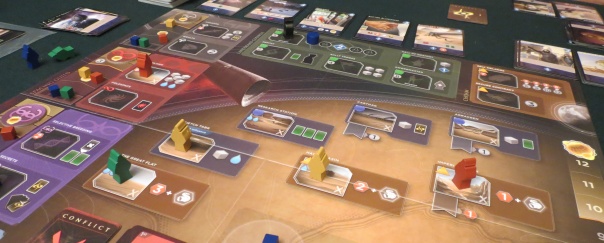
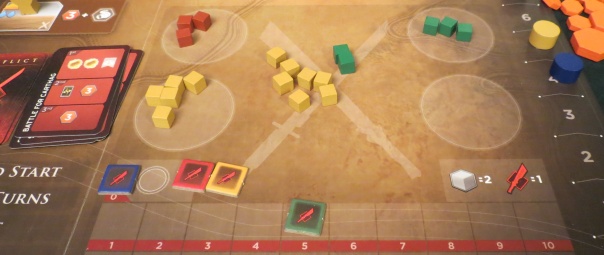
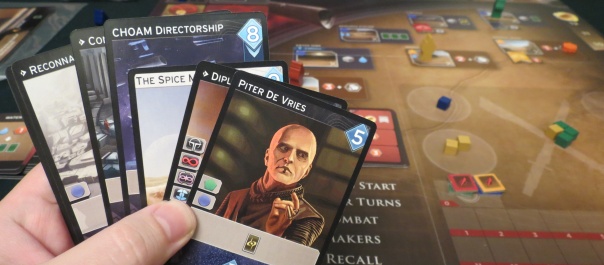
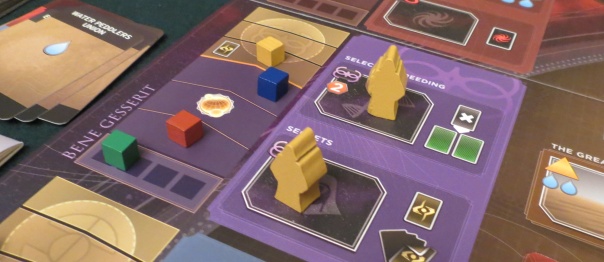
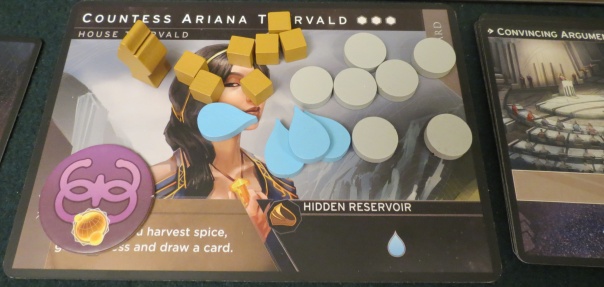
I am a big fan of Arctic Scavengers, so hearing that this does similar things to that but even better really makes me want to check this one out.
Thanks for another great review!
Thanks for reading, Dave!
The art looks like the last Jedi on Arrakis…
I’m not sure what I’m even supposed to visualize with that clue… then again, I don’t remember much of The Last Jedi.
my god you are such a glorious nerd
the gloriousest
I am pretty excited for this game, in no small part because it’s not the Avalon Hill 1979 classic (which is rightfully due its praise but still retains a multi-hour time commitment and some vague rules even after the release of GF9’s new edition). Imperium is akin to Dune for the rest of us- a thematic entry familiar-but-engaging mechanics that preserve a modicum of the strategic depth of its classic predecessor without its more finicky frustrations. Hopefully new players will discover the Dune universe in a way other than endureing an intimidating test of gaming stamina (or the occasional elitism I’ve encountered among a few hardcore disciples).
I’m curious to see what other publishers and developers will release in the years to come- as it is my understanding the Herbert Estate allowed license extensions to various subsidiaries (including at least one video game studio).
Great review (as always, Dan)! 🖖
Totally agree, Thomas. I love the GF9 edition, but it’s nice to play something Dune-ish that doesn’t take four hours minimum.
Thanks for the review, Dan!
I’m excited for this game and I was hoping that you’d review it. Glad to see that you liked it.
One rule question prompted by this sentence: “Another recruits an entire heighliner’s worth of sardaukar, but cannot yet deploy them”. On a combat space like “Heighliner”, can’t you always deploy all the units you just recruited this turn, plus up to two more?
Apart from that, I was wondering if you could comment on the 2-player game, as well as on component quality?
Thanks again for your review!
It’s true, there’s a space that deploys a literal heighliner of troops. I was thinking of the Landsraad space that purchases four troops, but only to your garrison. Guess I should have glanced at the board for a better description! So it goes.
To answer your questions, the components are perfectly fine as-is, and I can’t fathom paying more than the game’s value in order to buy the miniatures. Unless you’re into painting, I suppose. I’m not, and I don’t think miniatures add much value to most games, so the upgrade isn’t the sort of thing that appeals to me. Apart from that, everything seems quite sturdy. The cards are nice and thick and don’t do that irritating thing where they turn into Pringles if you leave them out overnight, the board’s coloration is crisp… perhaps the only downside is the flimsiness of the character mats, but that’s me looking for something to complain about.
The two-player game is fine, although I think it shines best at three- to four-players, probably best at three. With two you use the deck of rival cards, which simulates an extra player. Whether solo or in two-player, this feels like playing against a deck of cards because that’s exactly what you’re doing. It’s not bad, but it’s definitely not a dedicated solo game.
Thanks so much for taking the time to answer. And happy to hear the card quality is good, that’s the most important here, I think. I’ll also skip the upgrade pack. I was tempted at first but decided it was not worth it for me in the end.
Thank you for asking! I’m always happy to answer questions.
I guess there’s two kinds of people in the world: Dune people and Dune: Imperium people.
Guess that makes me a Dune agnostic.
I’m hoping it will be good as a solo game. Some of my favourite solo games involve playing against dummy players and decks of cards.
It’s serviceable. I didn’t love it, but it does provide a challenge.
Great read, but am surprised you mentioned deck building+ games and didn’t address Tyrants of the Underdark, which was a stellar, deck builder with area control mechanics. I would put it up with Clank and hopefully this game when it gets released!!!
True! Tyrants of the Underdark is a great example. It’s a testament to the increasing popularity of hybrid DBG designs that I can’t fit all of them in.
Times being what they were, Rio Grande Games swiftly locked it away to prevent it from competing with its father, likely the closest Dominion has ever gotten to accurately reflecting the Medieval Period.
Brilliant
Have played it several times now, and I went back and re-read your post for fun. Spot-on. Great game. And, as a fan of Frank Herbert’s 6 books, the theme just makes it just about perfect.
Glad to hear you’re enjoying it, Jeff!
I got to play the game for the first time last weekend, and I agree with everything onwhich you expounded here. Especially the slowing down reactionary nature of it. It was only a 3-player game, but toward the end we had several turns where someone stalled for 5 minutes because now they had to rethink everything.
I didn’t mind it; I had plenty to deliberate through before my next turn as well
And the gamestate retains all its tension in those pauses. But it should be considered when gauging interest and game length for the next play of the night.
Also, the art portraiture struck me. I love the depiction of the actors from the movie in place of still photographs from the movie. I can’t think of another board game that has done this, but to me it’s brilliant. It leaves just enough distance from reality that I can imagine myself in that character’s stillboots. Or cutting a deal with them when I draft their card. Or recoiling in horror when someone else gets hold of their personage first.
Agreed on the art — I love that they invested in illustrations rather than just using stills. Your point about how it lets you add some more imagination to each scene is well put.
Pingback: Review: Dune: Imperium:: Arrakis—Dune—Deck-Builder. (a Space-Biff! review) – Indie Games Only
Pingback: Best Week 2020! Uncommon Sense! | SPACE-BIFF!
Pingback: Boardgame Geek Top 300 – Play or Played – #260-251 – Dude! Take Your Turn!
Pingback: Brian “Big Balls” Boru | SPACE-BIFF!
Pingback: Slam Dunc | SPACE-BIFF!
Pingback: Clank! Again! | SPACE-BIFF!
Pingback: Dunc: Immorality | SPACE-BIFF!
Pingback: When I Roll Into the Wild Tiled West | SPACE-BIFF!
Pingback: Observe, Feyd-Rautha | SPACE-BIFF!